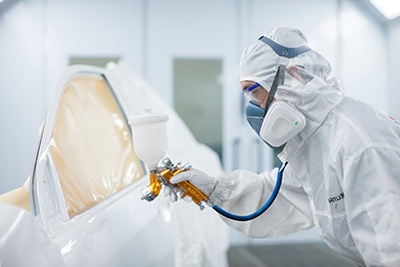Cleverly Solving Seven Common Paint Problems
Classification:
Company News
Release Time:
2025-06-26
Paint is a crucial part of interior decoration, but it can easily present some tricky problems that leave people at a loss. However, as long as you find the root cause of the problem and apply the right solution, it's not difficult to achieve satisfactory results. Below are some solutions to common paint problems, helping you to be more adept at interior decoration.
Paint Peeling
This may be due to an overly smooth surface. If the original coating is glossy or powdery (with unprocessed color paste paint), the new paint will not adhere well to the surface. Peeling can also be caused by rotting wood, rust on metal, or poor paint quality.
For small areas of peeling paint, first sand with fine sandpaper, then apply putty, a primer, and repaint. For large areas of peeling, all the paint must be scraped off and repainted.
Paint Blistering
First, pierce the blister. If water comes out, it means that moisture has seeped in under or behind the paint layer. When exposed to the sun, the water evaporates into steam, lifting the paint into blisters. In this case, use a hot air gun to remove the blistered paint, allow the wood to dry naturally, then apply a primer, and finally repaint the entire repaired area.
If no water is present in the blister, it may be due to wood cracking with a small amount of air inside. When exposed to the sun, the air expands, causing the paint to blister. For this, scrape off the blistered paint, fill the crack with resin filler, and repaint. Alternatively, without using filler, after scraping off the paint, directly apply microporous paint.
Cracking
In most cases, a chemical paint remover or hot air gun should be used to remove the paint before repainting.
If the crack is not large, use a sanding block or wet/dry sandpaper with water to sand away the cracked paint. After sanding the surface smooth, apply putty, a primer, and repaint.
Paint Runs
Applying too much paint at once will cause runs. While the paint is still wet, use a brush to spread it out. If the paint has started to dry, let it dry completely, sand the surface smooth with fine sandpaper, clean the surface, wipe with a damp cloth, and then repaint, being careful not to apply too much paint.
Stains
There are many reasons for stains on the paint surface. For example: moisture in latex paint dissolving substances on the wall and rusting through the paint, rust stains from using steel wool on the wall, stains from leaking pipes inside the wall, etc. To prevent stains, first apply a primer containing aluminum powder. If stains have already appeared, remove the latex paint from the stained area, apply a primer containing aluminum powder, and then repaint.
Mold and Discoloration
This problem often occurs on damp paint surfaces. For example, water vapor condensing on glass or metal surfaces often produces brownish-black stains. In this case, use a fungicide, following the instructions on the label, to treat the moldy area. After killing the mold, clean the surface and repaint.
Loss of Gloss
This is caused by not applying a primer, or applying glossy paint before the primer and undercoats are dry, resulting in the glossy paint being absorbed by the wood and losing its gloss. Poor quality glossy paint is also a reason.
Use wet/dry sandpaper to sand off the old paint, brush away the sanding dust, wipe the surface with a clean damp cloth, and let it dry completely before repainting.
It is important to note that painting in very cold environments can also cause the paint film to lose its gloss after drying.
Wrinkling of the Paint Film
This is usually caused by applying the second coat before the first coat is dry. The solvent in the lower layer of paint will affect the upper paint film, causing it to wrinkle.
A chemical paint remover or heating method can be used to remove the wrinkled paint film and repaint. Remember to let the first coat dry completely before applying the second coat.
Rough Paint Surface
A rough surface on newly painted surfaces is usually due to an unclean paintbrush or contamination from the surrounding environment. It may also be due to paint chips mixed in the paint that were not settled and filtered before use, or dust sticking to the paint before it dried.
To prevent these problems, use clean paintbrushes and buckets. Before using old paint, filter it with paint filter paper or a clean nylon stocking. In addition, cover the painted surface with a cover or cardboard while the paint is still wet to prevent dust from sticking.
If the paint surface is rough, after it dries completely, sand it smooth with wet/dry sandpaper, clean it, and repaint. Pay special attention to ensuring the paintbrush is clean.
Dark Spots Appearing on the Painted Wood Surface
This may be caused by unsealed knots in the wood. When exposed to the sun, the knots heat up, and resin seeps out of the knots. In this case, scrape off the paint, sand down to expose the knot, seal the knot with knotting paint, let it dry completely, and then repaint.
Paint Not Drying
Poor indoor ventilation or low temperatures will slow down the drying of the paint. Open all windows and doors to improve ventilation, or place a heater in the room to increase the temperature.
If the problem persists, the painted surface may be oily. Use a chemical paint remover or heating method to remove the paint, thoroughly clean the surface, and then repaint.
Insects Stuck to the Paint Surface
Try to remove the insects while the paint is still wet, then lightly repair the surface with a brush dipped in a little paint. If the paint has started to dry, wait until the paint film is completely hard before wiping off the insects. This will prevent damaging the surface.





Key Words:
The Previous One:
Car paint knowledge popularization and popular paint recommendations
The Next One:
More Information

